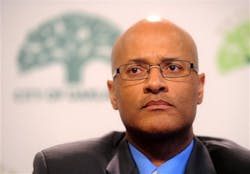'Occupy' Protests Put Police in Quandary
The chaotic street scene in Oakland where police clashed with Occupy Wall Street demonstrators last week was exactly the image law enforcement had hoped to avoid.
As a wounded protester was wheeled away, the demonstrators -- who have gathered in cities around the country to voice their opposition to the political influence wielded by big banks and major corporations -- added allegations of police brutality to their list of societal ills.
The Oakland Police Department has launched an investigation into how Iraq War veteran Scott Olsen, 24, was critically injured during an altercation between police and demonstrators. And more than a month after the protest movement began in Manhattan's Liberty Square, police agencies across the country are engaged in a struggle to preserve the right to public expression while maintaining the peace inside and outside the group's makeshift tent communities.
Samuel Walker, a criminal justice professor at the University of Nebraska, said the mass demonstrations draw comparisons to the sit-ins of the 1960s when aggressive police learned the hard way how not to handle large protests. "The lesson drawn from that era was restraint," he said. "Otherwise, you risk the backlash of creating an image of a police department out of control."
The Occupy movement is presenting some difficult challenges for police officials who are seeking to avoid physical confrontation, said Chuck Wexler, executive director of the Police Executive Research Forum, a law enforcement think tank in Washington. "What police do with any group of demonstrators is try to maintain a relationship with the (group's) leadership," he said, adding that communication is critical so that both sides "know the ground rules."
Wexler said there "are no real leaders in this movement. There are no real demands. It can be difficult. Police have lived with the images of the Vietnam era, when protests against the war turned to protests against police brutality. Arrests should almost be a last resort. Sometimes, though, your hand is forced."
In Austin on Sunday, police arrested 39 people early Sunday morning while enforcing a new ban on food tables after 10 p.m. in the City Hall plaza and while clearing an amphitheater for a regular power wash. Some protesters locked arms around the food tables, and others refused to leave the amphitheater, according to the Associated Press.
In Denver on Saturday evening, police in riot gear hauled off 15 demonstrators trying to establish an encampment just hours after a standoff at the Capitol steps degenerated into a fight that ended in a cloud of Mace and pepper spray. "There's a group of very committed people who believe in a cause, and then there are a few people who just want to cause trouble," Denver police spokesman Matt Murray told the AP.
In New York City, where police also have clashed with protesters, firefighters on Friday confiscated generators and fuel, which Mayor Michael Bloomberg said represented a safety hazard.
In San Diego, police arrested 51 demonstrators Friday after declaring an unlawful assembly. Police said they were responding to complaints about unsanitary conditions, including damage to public property. San Diego Police Chief William Lansdowne said negotiations with the demonstrators had broken down and officers received no cooperation, according to the AP.
In Boston, Police Commissioner Ed Davis said authorities are "taking it day by day" in their dealings with a core group of 200 protesters who are camped on the downtown Rose Kennedy Greenway. Two weeks into the occupation, Davis said 150 were arrested when there was an attempt to block a bridge. "You want to try to be patient an not interfere with people's First Amendment rights of free expression," he said. "There has only been a problem when they tried to block the flow of traffic."
Susan Riseling, police chief at the University of Wisconsin-Madison, where demonstrators also have established a foothold, said the national scope of the protest movement warrants a broader discussion in law enforcement about how to manage it. "We're in the middle of something that is bigger than what each of our cities are doing individually to respond to it,'' she said. "We need to learn from each other about what is working and what is a struggle.''
In the colorful tent community that nearly covers McPherson Square in downtown Washington, there is minimal police presence. And some are crediting local authorities with giving demonstrators ample room to express themselves.
When agitated protesters attempted to show their solidarity for their colleagues involved in the Oakland clash by planting a peace flag on the statue of the park's namesake, Maj. Gen. James McPherson, Occupy protester James Land, 38, said police calmly approached with a ladder and removed it.
"They didn't arrest anybody," Land said. "They grabbed the flag. End of story. They showed great restraint.''
Copyright 2011 Gannett Company, Inc.All Rights Reserved

